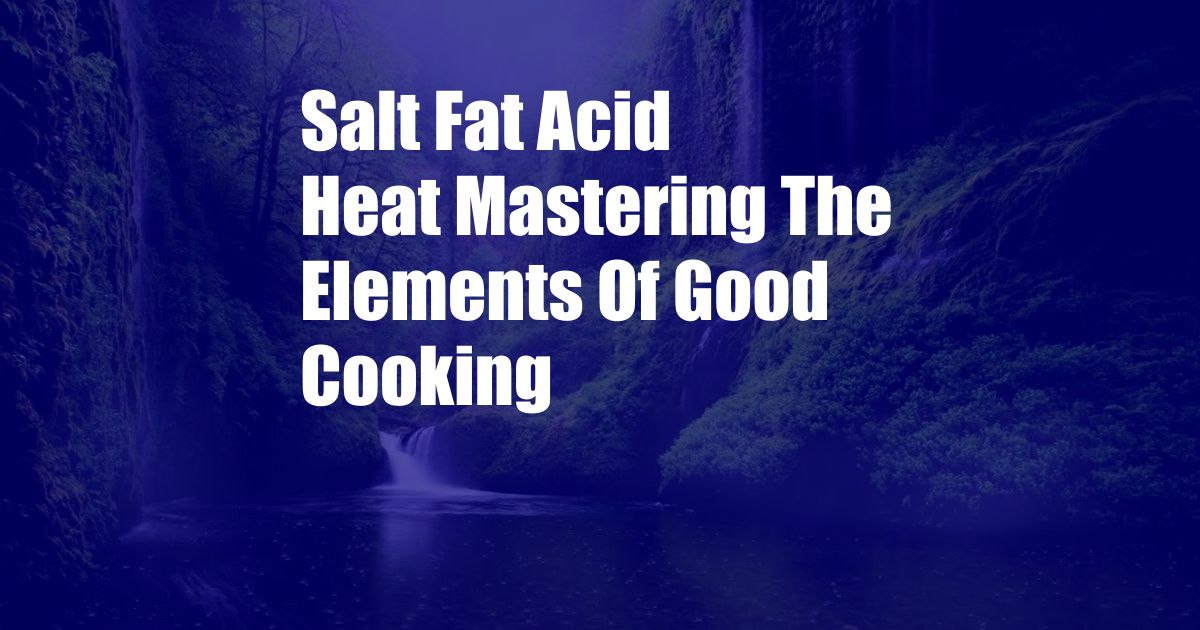
Salt, Fat, Acid, Heat: Mastering the Elements of Good Cooking
In the realm of cuisine, a symphony of flavors awakens our senses, transforming mere sustenance into culinary masterpieces. Four fundamental elements—salt, fat, acid, and heat—dance in perfect harmony, orchestrating a sensory experience that transcends sustenance. In Samin Nosrat’s enchanting work, “Salt, Fat, Acid, Heat: Mastering the Elements of Good Cooking,” she invites us on a culinary odyssey, unraveling the secrets of these culinary cornerstones.
Nosrat’s approach is deeply personal, drawing on her own culinary journey to illuminate the transformative power of these elements. She guides us through the intricacies of seasoning, the nurturing embrace of fats, the vibrant tang of acids, and the alchemizing dance of heat. This culinary quartet, she posits, holds the key to unlocking the full potential of our kitchens.
The Alchemy of Salt
Salt, the humble mineral, plays a pivotal role in enhancing flavor and balancing sweetness. Used judiciously, it can elevate dishes from bland to extraordinary. Nosrat emphasizes the importance of using salt as a seasoning, not an afterthought. By adding salt at different stages of cooking, we can draw out natural flavors, intensify sweetness, and counteract bitterness.
The type of salt also matters. Flaky sea salt imparts a delicate crunch and subtle flavor, while coarse kosher salt delivers a bolder, more pronounced presence. Beyond its culinary prowess, salt possesses a rich history, having been instrumental in shaping civilizations and preserving food for millennia.
The Embrace of Fat
Fats, often maligned for their caloric content, are indispensable in the culinary realm. They provide richness, tenderness, and essential flavor compounds. Nosrat explores the diverse world of fats, from saturated fats in butter to unsaturated fats in olive oil. Each fat exhibits unique properties, imparting distinct textures and flavors to dishes.
Fat also serves as a crucial medium for conveying heat, allowing us to sear, fry, and sauté. It creates a barrier between food and heat, preventing burning and promoting even cooking. Understanding the behavior of different fats in various cooking methods is key to mastering the art of creating delectable dishes.
The Tang of Acids
Acids, whether from citrus fruits, vinegar, or fermented foods, bring a vibrant zestiness to cuisine. They balance richness, brighten flavors, and stimulate our taste buds. Nosrat delves into the various types of acids and their roles in enhancing dishes. Citrus juices can add a refreshing acidity, while vinegar imparts a more assertive sourness. Fermented foods, like yogurt or sourdough, introduce complex flavors and a hint of umami.
The Mastery of Heat
Heat, the dynamic force that transforms raw ingredients into culinary delights, requires careful control to achieve optimal results. Nosrat explores the science of heat, explaining how different temperatures affect the chemical composition of food. From the gentle simmer of a slow-cooked stew to the intense heat of a searing grill, each temperature range imparts unique flavors and textures.
Understanding the interplay of these elements enables us to cook with precision, coaxing the fullest potential from our ingredients. By mastering salt, fat, acid, and heat, we unlock a world of culinary possibilities, transforming everyday meals into exceptional culinary experiences.
The Latest Trends and Developments
In the ever-evolving world of culinary arts, trends and developments emerge constantly. Nosrat’s work remains a timeless guidepost, providing the foundational principles upon which innovation can flourish. Modern chefs are incorporating these elements into contemporary dishes, creating exciting new flavor combinations and culinary experiences.
One notable trend is the exploration of umami, the savory fifth taste. Chefs are utilizing fermented ingredients, aged meats, and seaweed to introduce depth and complexity to dishes. Another trend is the emphasis on sustainability and seasonality, with chefs sourcing local, organic ingredients to create dishes that celebrate the bounty of nature.
Tips and Expert Advice
To elevate your culinary skills and fully harness the power of salt, fat, acid, and heat, embrace these expert tips:
- Taste as you cook: Season your dishes judiciously as you cook, balancing salt, fat, acid, and heat to create harmonious flavors.
- Use high-quality ingredients: Fresh, flavorful ingredients will yield the most delicious results. Source local, organic produce whenever possible.
- Experiment with different salts: Flaky sea salt, kosher salt, and Himalayan pink salt each impart unique textures and flavors. Try them in different dishes to discover your preferences.
- Don’t fear fat: Embrace healthy fats like olive oil, avocado oil, and nuts to add richness, flavor, and moisture to your dishes.
- Add acid strategically: Citrus juices, vinegar, and fermented foods can brighten flavors and balance richness. Use them sparingly to avoid overpowering dishes.
- Control heat precisely: Each cooking method requires a specific temperature range. Use thermometers to ensure accurate temperatures and optimal results.
Frequently Asked Questions
- What are the four elements of good cooking?
The four elements of good cooking are salt, fat, acid, and heat.
- Why is salt important in cooking?
Salt enhances flavor, balances sweetness, and draws out natural flavors in food.
- What is the role of fat in cooking?
Fat provides richness, tenderness, flavor, and allows for even cooking.
- How do acids contribute to cooking?
Acids balance richness, brighten flavors, and stimulate taste buds.
- What is the importance of heat control in cooking?
Controlling heat ensures optimal results, preventing burning, and promoting even cooking.
Conclusion
Salt, fat, acid, and heat are the cornerstone elements of good cooking, empowering us to create culinary masterpieces that tantalize our taste buds and delight our souls. By understanding the interplay of these elements and applying them with skill, we embark on a journey of culinary exploration and self-expression. Whether you’re a seasoned chef or an aspiring home cook, Nosrat’s “Salt, Fat, Acid, Heat” is an invaluable guide to unlocking the full potential of your kitchen.
Are you ready to embrace the culinary journey and experience the transformative power of these essential elements?